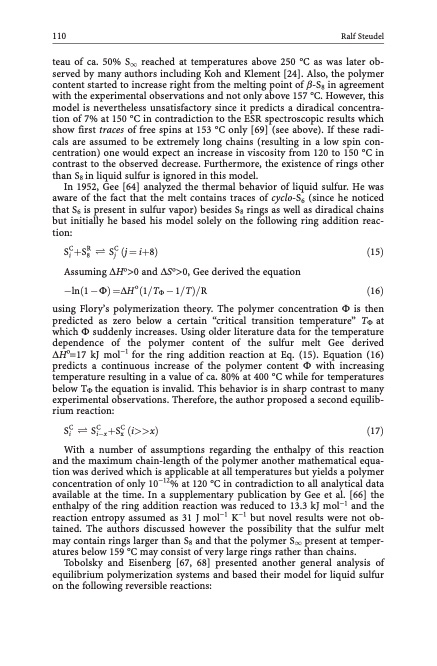
PDF Publication Title:
Text from PDF Page: 120
110 Ralf Steudel teau of ca. 50% S1 reached at temperatures above 250 C as was later ob- served by many authors including Koh and Klement [24]. Also, the polymer content started to increase right from the melting point of b-S8 in agreement with the experimental observations and not only above 157 C. However, this model is nevertheless unsatisfactory since it predicts a diradical concentra- tion of 7% at 150 C in contradiction to the ESR spectroscopic results which show first traces of free spins at 153 C only [69] (see above). If these radi- cals are assumed to be extremely long chains (resulting in a low spin con- centration) one would expect an increase in viscosity from 120 to 150 C in contrast to the observed decrease. Furthermore, the existence of rings other than S8 in liquid sulfur is ignored in this model. In 1952, Gee [64] analyzed the thermal behavior of liquid sulfur. He was aware of the fact that the melt contains traces of cyclo-S6 (since he noticed that S6 is present in sulfur vapor) besides S8 rings as well as diradical chains but initially he based his model solely on the following ring addition reac- tion: SCi þSR8 Ð SCj ðj 1⁄4 iþ8Þ ð15Þ Assuming DHo>0 and DSo>0, Gee derived the equation lnð1 FÞ 1⁄4DHoð1=TF 1=TÞ=R ð16Þ using Florys polymerization theory. The polymer concentration F is then predicted as zero below a certain “critical transition temperature” TF at which F suddenly increases. Using older literature data for the temperature dependence of the polymer content of the sulfur melt Gee derived DHo=17 kJ mol1 for the ring addition reaction at Eq. (15). Equation (16) predicts a continuous increase of the polymer content F with increasing temperature resulting in a value of ca. 80% at 400 C while for temperatures below TF the equation is invalid. This behavior is in sharp contrast to many experimental observations. Therefore, the author proposed a second equilib- rium reaction: SCi Ð SCixþSCx ði>>xÞ ð17Þ With a number of assumptions regarding the enthalpy of this reaction and the maximum chain-length of the polymer another mathematical equa- tion was derived which is applicable at all temperatures but yields a polymer concentration of only 1012% at 120 C in contradiction to all analytical data available at the time. In a supplementary publication by Gee et al. [66] the enthalpy of the ring addition reaction was reduced to 13.3 kJ mol1 and the reaction entropy assumed as 31 J mol1 K1 but novel results were not ob- tained. The authors discussed however the possibility that the sulfur melt may contain rings larger than S8 and that the polymer S1 present at temper- atures below 159 C may consist of very large rings rather than chains. Tobolsky and Eisenberg [67, 68] presented another general analysis of equilibrium polymerization systems and based their model for liquid sulfur on the following reversible reactions:PDF Image | Topics in Current Chemistry

PDF Search Title:
Topics in Current ChemistryOriginal File Name Searched:
Elemental-Sulfur-und-Sulfur-Rich-Compounds-I.pdfDIY PDF Search: Google It | Yahoo | Bing
Sulfur Deposition on Carbon Nanofibers using Supercritical CO2 Sulfur Deposition on Carbon Nanofibers using Supercritical CO2. Gamma sulfur also known as mother of pearl sulfur and nacreous sulfur... More Info
CO2 Organic Rankine Cycle Experimenter Platform The supercritical CO2 phase change system is both a heat pump and organic rankine cycle which can be used for those purposes and as a supercritical extractor for advanced subcritical and supercritical extraction technology. Uses include producing nanoparticles, precious metal CO2 extraction, lithium battery recycling, and other applications... More Info
| CONTACT TEL: 608-238-6001 Email: greg@infinityturbine.com | RSS | AMP |